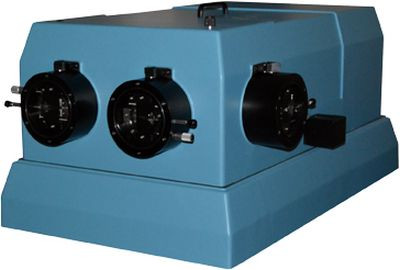
High Throughput in Low Light Applications
The Model 207 offers the user the most throughput and fastest aperture in a long focal length monochromator. This is ideal for photoluminescence and Raman spectroscopy applications. It is also available in a vacuum compatible version. Used in air and with a selection of gratings, the spectral range of the 207 extends from 185 nanometersm to 20 microns or more. Under vacuum range is extended down to 105 nm (depends on the grating.) Multiple ports are available for mounting accessories or CCD detectors, etc. McPherson SNAP IN gratings allow the alignment-free use of many different gratings. Easily view a wider spectral range or obtain higher resolution! You can retrofit years later and not have to worry about alignment with the McPherson SNAP IN approach. Our dual grating turret also accepts these easy to exchange gratings.
Stigmatic Model 207A Monochromator (with off-axis parabolic optics) Press Release
| Optical Design | Czerny Turner with Patented "Snap-In" gratings |
| Focal Length | 0.67 meter |
| Aperture Ratio | 4.7 (5.8 with smaller grating) |
| Wavelength Range | refer to grating of interest for range, in extended position increase top limit 20% |
| Wavelength Accuracy | +/- 0.05 nm (with 1200 G/mm grating) |
| Wavelength Reproducibility | +/- 0.005 nm (with 1200 G/mm grating) |
| Grating Size | 120x140 mm (or 110x110mm) - oversize Echelle gratings to 220mm wide |
| Slit Locations | Axial and lateral with optional entrance and exit port selection mirrors |
| Focal Plane | 50 mm maximum width, multiply dispersion by the width of your detector for range |
| Grating (G/mm) (others available) | 3600 | 2400 | 1800 | 1200 | 600 | 300 | 150 | 75 | 20 |
| Wavelength Range from 185-nm to | 435nm | 650nm | 860nm | 1.3um | 2.6um | 5.2um | 10.4um | 20.8um | 78um |
| Resolution (nm)1 | 0.015 | 0.02 | 0.03 | 0.04 | 0.08 | 0.16 | 0.32 | 0.64 | 2.4 |
| Dispersion (nm/mm) | 0.42 | 0.62 | 0.83 | 1.24 | 2.48 | 4.96 | 9.92 | 19.84 | 74.4 |
| First Order Littrow Blaze (nm)2 | Holo | 240nm | Holo | 250nm | 300nm | 750nm | 1.25um | 2.0um | 45um |
| 300nm | 300nm | 500nm | 1.0um | 2.5um | 3.0um | ||||
| Holo | 500nm | 750nm | 3.0um | 4.0um | 8.0um | ||||
| 750nm | 1.0um | 4.0um | 6.0um | 10.0um | |||||
| 1.0um | 1.85um | 8.0um | 12.0um | ||||||
1. Tested in scanning mode at 312/313 nanometers with 10 micron wide slits and at slowest aperture ratio
2. Gratings work best from 2/3 blaze wavelength to 3/2 blaze wavelength